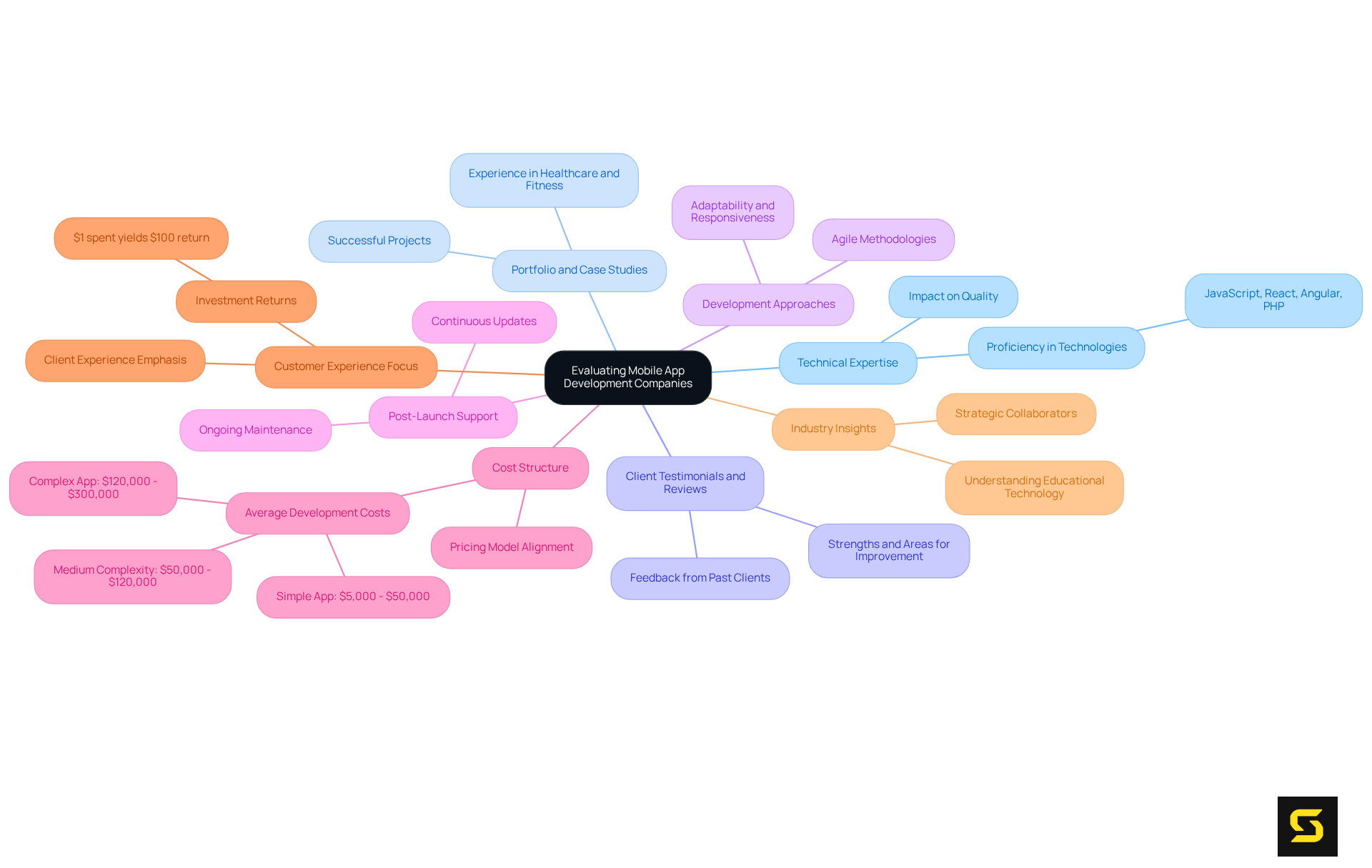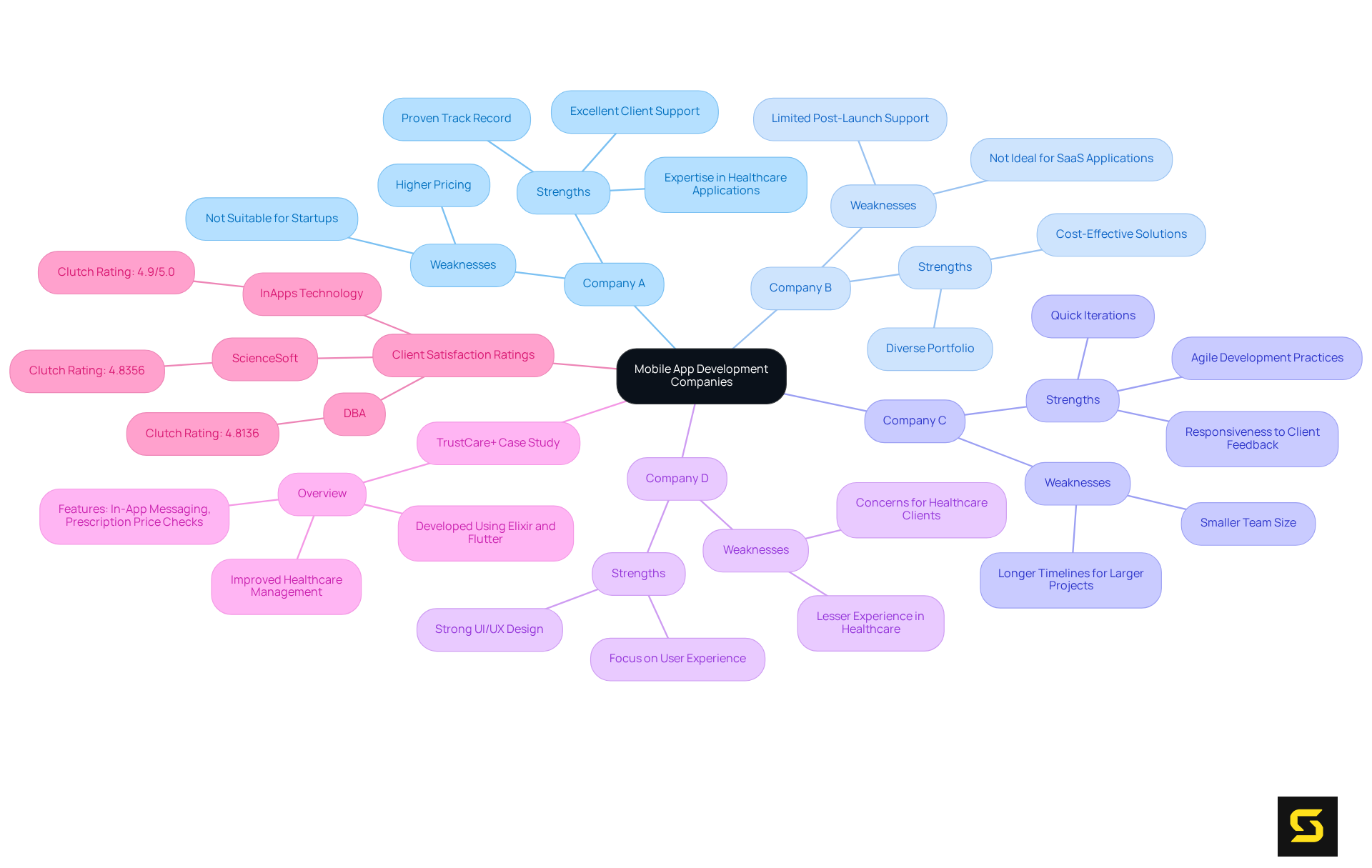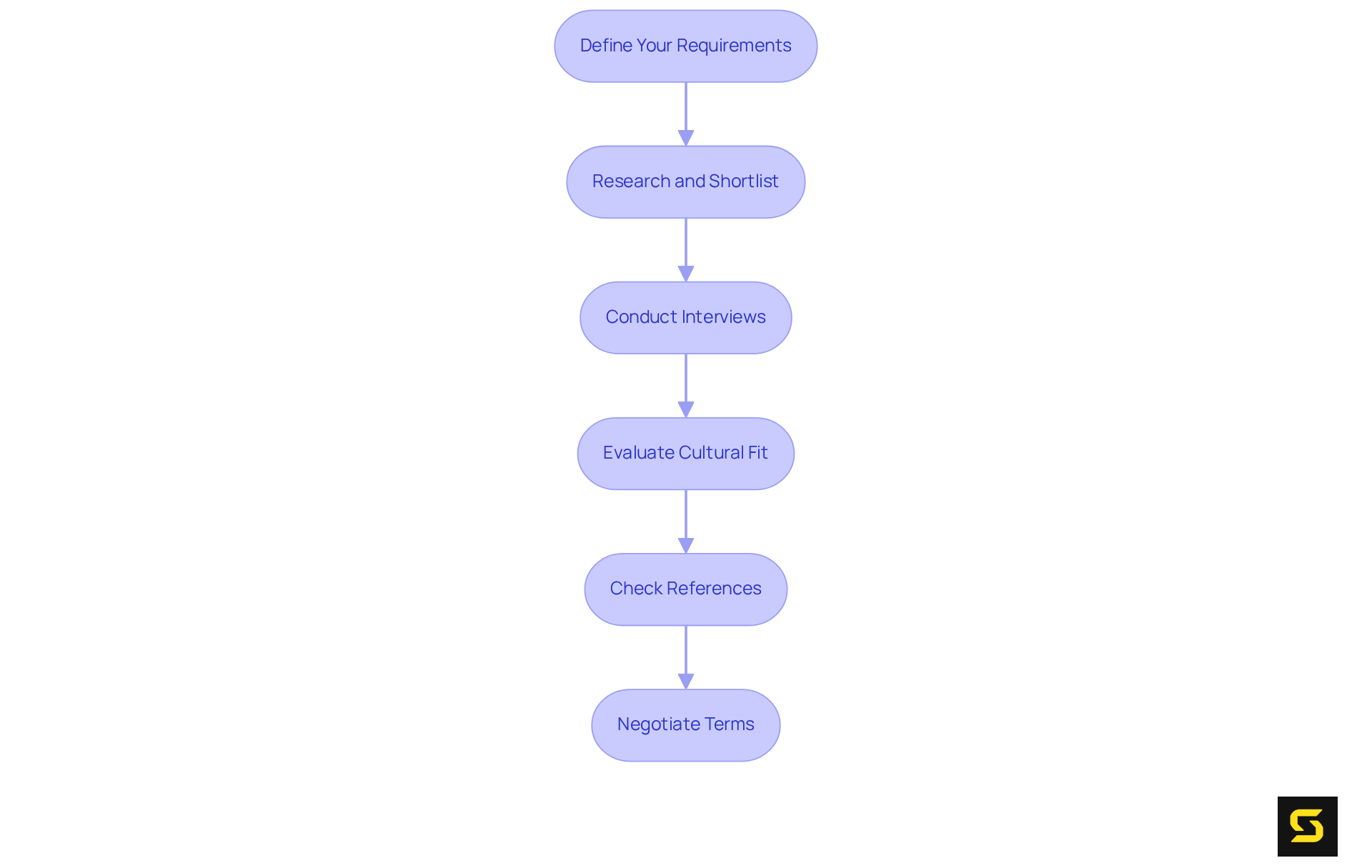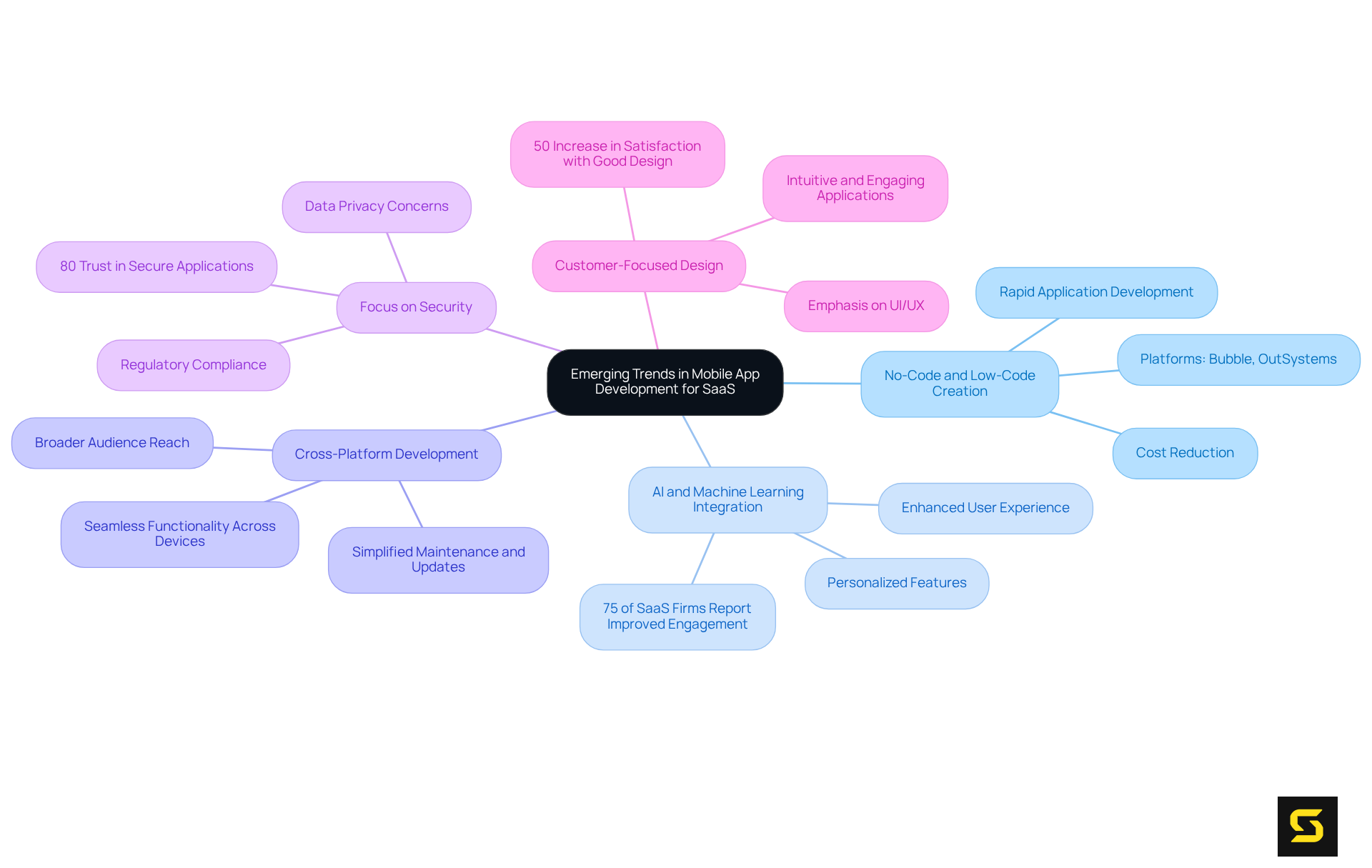Overview
Evaluating mobile application development companies is essential for achieving SaaS success. Key criteria to consider include:
- Technical expertise
- Portfolio
- Client testimonials
- Development approaches
- Post-launch support
- Cost structure
- Customer experience focus
- Industry insights
Each of these factors plays a pivotal role in ensuring that your chosen partner aligns with your business goals. By selecting a development company that excels in these areas, you can secure high-quality, effective applications tailored to meet user needs. Take action now—choose wisely to ensure your SaaS venture thrives.
Introduction
In the rapidly evolving world of Software as a Service (SaaS), selecting a mobile application development partner is pivotal to project success. With numerous firms competing for attention, the process extends beyond a mere glance at portfolios; it necessitates a thorough examination of technical expertise, client satisfaction, and adaptability to industry trends. As organizations aim to enhance user experience and functionality, a critical question emerges: how can SaaS product owners effectively assess these companies to ensure their success? This article delves into the essential criteria and emerging trends that will empower decision-makers to navigate this complex landscape.
Key Criteria for Evaluating Mobile App Development Companies
When evaluating mobile app development companies, several key criteria must be considered:
-
Technical Expertise: Assess the organization’s proficiency in essential technologies such as JavaScript, React, Angular, and PHP—crucial for developing robust SaaS applications. A strong technical foundation directly impacts the quality and functionality of the final product, making this an indispensable criterion.
-
Portfolio and Case Studies: Review past projects to gauge the organization’s experience in delivering similar solutions, particularly in the healthcare and fitness sectors. Successful projects, including mobile applications that enhance clinical efficiency or boost patient engagement, serve as indicators of an organization’s capability.
-
Client Testimonials and Reviews: Seek feedback from past clients to understand the organization’s reliability and quality of service. Positive testimonials highlight strengths, while constructive criticism offers insights into areas for improvement, providing a well-rounded view of the company’s performance.
-
Development Approaches: Evaluate whether the organization employs Agile or other contemporary methodologies that promote adaptability and responsiveness throughout the creation process. A significant number of mobile application development companies utilize Agile practices, enhancing collaboration and flexibility.
-
Post-Launch Support: Consider the level of ongoing support and maintenance provided after the app's launch, which is vital for SaaS products requiring continuous updates and improvements. A dependable support framework ensures that the app remains functional and attuned to evolving audience needs.
-
Cost Structure: Analyze the pricing model to ensure alignment with your budget while delivering value for the services rendered. Understanding the cost implications of various project phases, such as design and testing, aids in making informed financial decisions. For instance, the average cost to develop a simple app ranges from $5,000 to $50,000, offering a clearer financial context for your evaluation.
-
Customer Experience Focus: Prioritize companies that emphasize client experience in their development process. Statistics reveal that every $1 invested in enhancing experience can yield up to $100 in return, underscoring the importance of funding this area.
-
Industry Insights: Incorporate insights from industry leaders, such as Roshan Choudhary, who stresses the need for a strategic collaborator that understands educational technology and prioritizes user experience design.
By considering these criteria, SaaS product owners can make informed choices when selecting mobile application development companies as their partners, ensuring their projects are successful and aligned with their business goals.

Strengths and Weaknesses of Leading Mobile App Development Companies
In the competitive landscape of mobile application development companies, leading firms exhibit distinct strengths and weaknesses that define their market positioning.
-
Company A demonstrates strong expertise in healthcare applications, boasting a proven track record of successful projects and excellent client support. However, its higher pricing compared to competitors may not be suitable for startups.
-
Company B offers cost-effective solutions and maintains a diverse portfolio across various industries. Yet, its limited post-launch support can be a significant drawback for SaaS applications requiring ongoing maintenance.
-
Company C employs agile development practices, allowing for quick iterations and responsiveness to client feedback. Conversely, its smaller team size may lead to longer timelines for larger projects.
-
Company D focuses on user experience and UI/UX design, enhancing overall app engagement. Nonetheless, its lesser experience in specific sectors like healthcare may raise concerns for clients within that industry.
To illustrate the effectiveness of mobile app creation in healthcare, the TrustCare+ application serves as a notable case study. Developed using Elixir for the backend and Flutter for the frontend, it has transformed the healthcare experience by allowing patients to manage their healthcare conveniently. With features such as in-app text messaging and prescription price checks, this application not only exceeded initial objectives but also laid the groundwork for future scalability.
Incorporating insights from industry leaders enhances this analysis. Warren Herring, CEO of TrustCare, emphasized the importance of a tailored patient-facing application, stating, "The goal was to transform the way patients and providers communicate and manage healthcare, embodying TrustCare's ethos."
Moreover, client satisfaction ratings provide a standard for assessing the performance of mobile application development companies. For instance, InApps Technology boasts a Clutch rating of 4.9/5.0, while ScienceSoft holds a rating of 4.8356, demonstrating high client satisfaction in the healthcare app creation sector.
By integrating these elements, the analysis not only highlights the strengths and weaknesses of leading companies but also provides concrete examples and authoritative insights that enhance its credibility.

Choosing the Right Mobile App Development Partner for Your SaaS Needs
Selecting the right mobile app development partner for your SaaS needs involves several strategic steps:
- Define Your Requirements: Clearly outline your project goals, target audience, and specific features needed in the app. This clarity is essential for effectively evaluating potential partners. Statistics indicate that 25% of users abandon an app after a single use, underscoring the necessity of a well-defined project scope.
- Research and Shortlist: Utilize key criteria to create a shortlist of organizations that align with your technical and business needs. This critical step ensures that you focus on mobile application development companies that are capable of delivering the desired outcomes.
- Conduct Interviews: Engage with selected firms to discuss your project in detail. Assess their understanding of your requirements and the solutions they propose, ensuring alignment with your vision.
- Evaluate Cultural Fit: Consider the organizational culture and communication style. A strong cultural fit can significantly enhance collaboration and project success, fostering a productive working relationship. Successful SaaS founders frequently emphasize the importance of cultural alignment in their partnerships.
- Check References: Request references from previous clients to gain insights into the company's reliability and quality of work. This feedback can provide valuable context for your decision-making process.
- Negotiate Terms: Once a suitable partner is identified, negotiate terms that include timelines, deliverables, and post-launch support. This ensures mutual understanding and commitment, setting the stage for a successful partnership.

Emerging Trends in Mobile App Development for SaaS
As the mobile app development landscape evolves, several emerging trends are decisively shaping the future of SaaS applications:
-
No-Code and Low-Code Creation: These platforms are rapidly gaining traction, empowering businesses to create applications with minimal coding. This shift significantly reduces both creation time and costs. Notable platforms like Bubble and OutSystems exemplify this trend, facilitating rapid application development.
-
AI and Machine Learning Integration: The incorporation of AI capabilities into SaaS applications markedly enhances user experience through personalized features and predictive analytics. A recent study revealed that 75% of SaaS firms utilizing AI reported improved engagement and retention rates.
-
Cross-Platform Development: The demand for cross-platform solutions continues to rise, enabling developers to create applications that function seamlessly across multiple devices and operating systems. This strategy not only broadens audience reach but also simplifies maintenance and updates.
-
Focus on Security: In light of growing concerns regarding data privacy, mobile application development companies are prioritizing security features to protect data and comply with regulations. According to a report, 80% of individuals are more inclined to trust applications that demonstrate robust security measures.
-
Customer-Focused Design: There is an increasing emphasis on UI/UX design, ensuring that applications are intuitive and engaging for users, which is critical for SaaS success. Industry specialists assert, "A well-crafted interface can enhance satisfaction by up to 50%, directly influencing adoption rates."
By concentrating on these pivotal trends, SaaS companies can significantly enhance their offerings and adeptly meet the evolving needs of their users.

Conclusion
Evaluating mobile application development companies is not just a step; it is a critical determinant of SaaS success. By concentrating on essential criteria such as technical expertise, portfolio quality, client feedback, and post-launch support, SaaS product owners can make informed decisions that align seamlessly with their business objectives. Grasping these elements is paramount in identifying a partner capable of delivering a high-quality application that not only meets user needs but also enhances engagement.
This article delineates several crucial factors to consider when selecting a development partner. From assessing the technical skills and methodologies employed by companies to analyzing their strengths and weaknesses, every aspect plays a vital role in the overall evaluation process. Furthermore, recognizing emerging trends such as no-code platforms and AI integration can further inform strategic choices, ensuring that the selected partner remains at the forefront of a competitive landscape.
Ultimately, the success of a SaaS application hinges on establishing the right partnership. By dedicating time to thoroughly evaluate potential mobile app development companies, stakeholders can secure a collaboration that not only meets current requirements but also adapts to future challenges. This proactive approach will significantly enhance the likelihood of creating a successful and sustainable SaaS product in an ever-evolving market.
Frequently Asked Questions
What technical skills should I look for in a mobile app development company?
Look for proficiency in essential technologies such as JavaScript, React, Angular, and PHP, as these are crucial for developing robust SaaS applications.
Why is it important to review a company's portfolio and case studies?
Reviewing past projects helps gauge the organization’s experience in delivering similar solutions, particularly in specific sectors like healthcare and fitness, indicating their capability.
How can client testimonials and reviews help in evaluating a mobile app development company?
Feedback from past clients provides insights into the organization’s reliability and quality of service, highlighting strengths and areas for improvement.
What development approaches should a good mobile app development company use?
Evaluate whether the organization employs Agile or other contemporary methodologies that promote adaptability and responsiveness during the development process.
Why is post-launch support important for mobile applications?
Ongoing support and maintenance after the app's launch are vital for SaaS products, ensuring continuous updates and improvements to meet evolving audience needs.
How should I analyze the cost structure of a mobile app development company?
Assess the pricing model to ensure it aligns with your budget while delivering value. Understanding the cost implications of various project phases, such as design and testing, is essential for making informed financial decisions.
What is the potential return on investment for enhancing customer experience in app development?
Statistics show that every $1 invested in enhancing customer experience can yield up to $100 in return, highlighting the importance of prioritizing this area.
What industry insights should I consider when choosing a mobile app development company?
Incorporate insights from industry leaders, such as the need for a strategic collaborator that understands educational technology and prioritizes user experience design.





